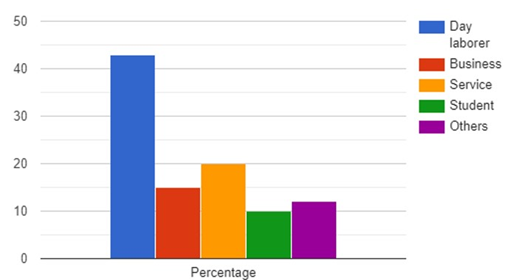Evaluation of the prevalence of different types of hepatitis viruses in a tertiary care hospital
Abstract
Background: Bangladesh is not exempt from the global viral hepatitis pandemic. Hepatotropic viruses comprise the majority of those that cause viral hepatitis. Hepatitis B virus (HBV), with hepatitis C virus (HCV), hepatitis A virus (HAV), and hepatitis E virus, is one of the most important hepatotropic viruses (HEV). The objective of the current study was to determine if individuals who were clinically thought to have the aforementioned diseases were also seropositive for HBV, HCV, HEV, and HAV.
Aim of the study: This study's objective was to determine the prevalence, typical causes, mode of transmission, and risk factors associated with acute viral hepatitis.
Methods: This descriptive cross-sectional study was carried out between March 2012 and September 2012, in the department of Medicine, Shaheed Ziaur Rahman Medical College hospital in Bogura. In total 100 cases of acute viral hepatitis, patients were included in this study. These cases were included and excluded based on the inclusion and exclusion criteria. Information was acquired using a questionnaire after receiving written, informed consent, and applicable research was done. The information was then looked over.
Results: The study comprised 100 cases of acute viral hepatitis in total. In this study, acute viral hepatitis is most frequently caused by the hepatitis E virus (52%), with a peak incidence in people between the ages of 32 and 41. Hepatitis A virus (32%), which is most prevalent in people between the ages of 12 and 21 (54.55%), is the second most common cause. At a ratio of 7.33:1, males were more frequently impacted than females. The workforce was made up of 43%-day workers, 20% employees, 15% business owners, 10% students, and 12% others.
Conclusion: An increase in new instances of hepatitis B, C, and D was observed in Bangladesh, according to a study of their prevalence. These findings show that individuals in high-risk groups require the development of efficient preventative interventions and screening procedures. To determine the significance of diverse acute hepatitis causative agents in Bangladesh, more research is required.
Downloads
References
Cuthbert JA. Hepatitis A: old and new. Clin Microbiol Rev 2001; 14: 36-58.
Koff RS. Hepatitis A. Lancet 1998; 351: 1643-1649.
Mahtab M.A., Rahman S., Khan M., Karim M.F. HEV Infection as an Aetiologic 1 Factor for Acute Hepatitis: Experience from a Tertiary Hospital in Bangladesh. J Health Popul Nutr. 2009a; 27(1): 14-19.
Chowdhury B.O., Ahamad M.S.U., Farooque A.H.M.O., Rahman A.J.E.N. Study on the association of Hepatocellular Carcinoma with Hepatitis B Virus Infection: Bangladesh Perspective. Journal of Chittagong Medical College Teachers' Association. 2009; 20(1):31-33.
Hollinger FB, Ticehurst JR. Hepatitis A virus. In: Fields Virology. 3rd ed. Philadelphia: LippincottRaven; 1996. p. 735-782.
World Health Organisation "Fact Sheet No 204 - Hepatitis B." (August 2008).
Zuckerman, J.N. Hepatitis--how far down the alphabet? J Clin Pathol. 1997; 50:
Maheshwari A, Ray S, Thuluvath PJ. "Acute hepatitis C". Lancet 2008; 372 (9635): 321-32.
Nelson PK, Mathers BM, Cowie B, Hagan H, Des Jarlais D, Horyniak D, et al. "Global epidemiology of hepatitis B and hepatitis C in people who inject drugs: results of systematic reviews". Lancet 2011; 378 (9791): 571-83.
Makino S, Chang MF, Shieh CK, Kamahora T, Vannier DM, Govindaranjan S, et al. "Molecular cloning and sequencing of a human hepatitis delta (delta) virus RNA". Nature 1987; 329 (6137): 343-6.
Fattovich G, Giustina G, Christensen E, Pantalena M, Zagni I, Realdi G, et al. Influence of hepatitis delta virus infection on morbidity and mortality in compensated cirrhosis type B.The European Concerted Action on Viral Hepatitis (Eurohep) Gut. 2000; 46:420-6.
World Medical Association. (2001). World Medical Association Declaration of Helsinki. Ethical principles for medical research involving human subjects. Bulletin of the World Health Organization, 79 (4), 373 - 374. World Health Organization.
Voigt, Paul, and Axel von dem Bussche. & quot; Enforcement and fines under the GDPR." The EU General Data Protection Regulation (GDPR). Springer, Cham, 2017. 201-217.
Hamid SS, Atiq M, Shehzad F, Yasmeen A, Nissa T, Salam A, et al. Hepatitis E virus superinfection in patients with chronic liver disease. Hepatology. 2002; 36:474-8.
Khuroo MS, Rustgi VK, Dawson GJ, Mushahwar IK, Yattoo GN, Kamili S, et al. Spectrum of hepatitis E virus infection in India. J Med Virol. 1994; 43:281-6.
Khuroo MS. Discovery of hepatitis E: the epidemic non-A, non-B hepatitis 30
Chadha MS, Walimbe AM, Chove LP, Arankalle VA. Comparison of etiology of sporadic acute and fulminant viral hepatitis in hospitalized patients in Pune, India during 1978-81 and 1994-97. Indian J Gastroenterol. 2003 Jan-Feb; 22(1): 11-5.
Amin M Z, Siddique L N, Satter M A, and Biswas K K. Increasing incidence of hepatitis A in Bangladesh. Bangladesh J. Sci. Ind. Res. 2012; 47(3): 309-312.
Khan WI, Sultana R, Rahman M, Akhter H, Haq JA, Ali L, et al. Viral Hepatitis: Recent Experiences from Serological Studies in Bangladesh. Asian Pacific Journal of Allergy and Immunology. 2000;18: 99103.
Chau TN, Lai ST, Lai JY, Yuen H. Acute viral hepatitis in Hong Kong: a study of recent incidences. HKMJ 1997; 3:261-6.
Mechnik, Laura MD. Acute Hepatitis E Virus Infection Presenting as Prolonged Cholestatic Jaundice. Journal of Clinical Gastroenterology.2001; 33(5): 421-422.



























